For those who have not seen it, the plot revolves around three characters: ballet company impresario Boris Lermontov (Anton Walbrook), ballerina Vicky Page (Moira Shearer), and composer Julian Craster (Marius Goring). Each is dedicated to the musical arts, but to varying degrees.
 |
| Anton Walbrook as Lermontov. |
Julian is dedicated to his music. He wakes up in the middle of the night thinking about it and rushes to the piano to transcribe it. However, Julian can balance his profession and his personal life, especially after he falls in love with Vicky.
Vicky is torn between her need to dance and her love for Julian. Like Lermontov, she is obsessed with ballet and cannot live without it. Yet, she loves Julian passionately and cannot envision a life without him. When circumstances prevent her from dancing for Lermontov's company and being with Julian, Vicky confronts an existence that's burning from both ends.
While the characters portray the conflict between art and "real life," director Michael Powell visualizes it for the audience. The centerpiece of The Red Shoes is an audacious original ballet that literally pulls the viewer from the audience into an imaginary world. Powell opens the scene showing the curtains drawing back to reveal a solitary dancer, a shoe cobbler holding red ballet slippers, on the stage. Then, he cuts to a shot of the village that crops out the framing of the stage. The viewer is now on the stage with the performers and immersed into their world.
 |
| Vicky dancing with a newspaper man. |
 |
| The controlling ballet shoes. |
Anton Walbrook is the standout among the cast. In his third Powell-Pressberger film, Walbrook gets a chance to portray a complex character that straddles the line between supportive and manipulative. Lermontov is an unforgiving taskmaster, but he recognizes artistic brilliance and supports it. When Vicky wants to leave the ballet company to be with Julian, Lermontov releases her from her contract. But when given a chance to see her again, he pressures her to come back into the fold. He wants to be gracious, but ultimately he must do what he feels is right for the ballet company.
Do I now rank The Red Shoes over Black Narcissus? No, the latter is still my favorite Powell & Pressberger film. But I am glad I watched The Red Shoes again. I have grown to admire its dazzling colorful imagery, Powell's bold directing, and the film's exploration of the thin line between real world and the fantasy world created through visual and aural artistry.











